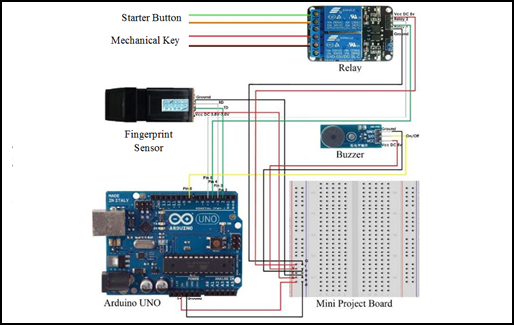Main Article Content
Abstract
Cases of motorcycle theft by breaking mechanical key are still a serious problem in some countries. Therefore, this article discusses the process of development, implementation, and evaluation of a fingerprint-based ignition key for motorcycles. To prevent theft, a motorcycle can only be turned on by a registered fingerprint, and an alarm will ring if the sensor receives an unregistered fingerprint. This prototype used the main component of the SEN0188 fingerprint sensor, Arduino Uno microcontroller, LM317 voltage regulator, and the buzzer alarm module. The test results in shaded place showed that the proposed key successfully ignited the engine by 80% with a dry and clean thumb. However, if the thumb is oily or dirty, the success scanning rate is only 36% of 25 attempts. The proposed key also successfully activates a warning alarm if a fingerprint scan attempt fails three times in a row. Test results on potholes, bumpy, dusty, and puddles roads indicate that no hardware has been disturbed or damaged. Therefore, this prototype has the potential to be further developed and implemented on a large scale in an effort to reduce motorcycle theft rates.
Keywords
Article Details

This work is licensed under a Creative Commons Attribution-NonCommercial 4.0 International License.
References
- BPS, “Crime Statistic 2019,” Statistics Indonesia, 2019. [Online]. Available: https://www.bps.go.id/publication/2019/12/12/66c0114edb7517a33063871f/statistik-kriminal-2019.html.
- U. A. Ojedokun and E. A. Ogundipe, “Motorcycle theft victimization in Oyo town, Nigeria: A qualitative analysis,” International Journal of Criminal Justice Sciences, vol. 12, no. 1, pp. 45–56, 2017.
- D. J. Barrera et al., “Motor Vehicle Theft in Negros Oriental Philippines: Patterns Across Space, Time, and Targets,” Prism, vol. 20, no. December, pp. 1–16, 2015.
- Z. A. Ghani, “A comparative study of urban crime between Malaysia and Nigeria,” Journal of Urban Management, vol. 6, no. 1, pp. 19–29, 2017.
- R. M. Susanto, T. Nurrochman, S. Munahar, and A. I. Ramadhan, “Design and Application of Electronic Tracking Control Systems (ETCS) to Improve Vehicle Safety,” Automotive Experiences, vol. 2, no. 3, pp. 67-72, 2019.
- H. Fahrian, S. Munahar, and D. S. Putra, “Pengembangan Sirkuit Security System untuk Meningkatkan Driver Behaviour Control pada Kendaraan,” Automotive Experiences, vol. 1, no. 01, pp. 13-19, 2018.
- P. Singh, T. Sethi, B. B. Biswal, and S. K. Pattanayak, “A Smart Anti-theft System for Vehicle Security,” International Journal of Materials, Mechanics and Manufacturing, vol. 3, no. 4, pp. 249-254, November 2015.
- Y. D. Austria, L. L. Lacatan, J. G. D. Funtera, S. C. Garcia, J. H. Montenegro, and L. T. Santelices, “Face recognition for motorcycle engine ignition with messaging system,” International Journal of Computing Sciences Research, vol. 1, no. 3, pp. 38-49, 2017.
- A. O. Pachica, D. S. Barsalote, J. M. P. Geraga, J. M. Ong, and M. D. Sajulan, “Motorcycle Theft Prevention and Recovery Security System,” International Journal of Applied Engineering Research, vol. 12, no. 11, pp. 2680-2687, 2017.
- W. W. I. Wan Jusoh, K. A. Mohd Annuar, S. H. Johari, I. M. Saadon, and M. H. Harun, “Motorcycle Security System using GSM and RFID,” Journal of Advanced Research in Applied Mechanics, vol. 16, no. 1, pp. 1-9, 2015.
- T. V. D. Putte, and J. Keuning, “Biometrical Fingerprint Recognition: Don't Get Your Fingers Burned,” IFIP CARDIS, 2000, 289-303, 2000.
- A. Utzhanova, 2016, “Fingerprint Technology and Sustainable Development,” European Journal of Sustainable Development, vol. 5,no. 4, pp. 325-334, 2016.
- A. El-Sisi, “Design and Implementation Biometric Access Control System Using Fingerprint for Restricted Area Based on Gabor Filter,” The International Arab Journal of Information Technology, vol. 8, no. 4, pp. 355-363, October 2011.
- S. S. Mudholkar, P. M. Shende, and M. V. Sarode, “Biometrics Authentication Technique For Intrusion Detection Systems Using Fingerprint Recognition,” International Journal of Computer Science, Engineering and Information Technology (IJCSEIT), vol.2, no.1, pp. 57-65, February 2012.
- J. Kalunga, and S. Tembo, “Development of Fingerprint Biometrics Verification and Vetting Management System,” American Journal of Bioinformatics Research, vol. 6, no. 3, pp. 99-112, 2016.
- S. G. Eze, and E. O. Chijioke, “Public Enlightenment Education on the acceptance of Fingerprint Biometric Technology for administration in academic institutions and other organizations,” Journal of Education and Practice, vol.7, no.28, pp. 158-163, 2016.
- Y. H. Jo, S. Y. Jeon, J. H. Im, and M. K. Lee, “Security Analysis and Improvement of Fingerprint Authentication for Smartphones,” Mobile Information Systems, vol. 2016, pp. 1-11, 2016.
- W. Yang, S. Wang, J. Hu, G. Zheng, and C. Valli, 2019, “Security and Accuracy of Fingerprint-Based Biometrics: A Review,” Symmetry, vol. 2019, no. 11, pp. 1-19, 2019.
- W. E. Yudiatmaja, T. Samnuzulsari, Alfiandri, and S. Mahdalena, “Fingerprint, Monitoring and Work Discipline of Indonesian Public Servants: Evidence from Kepulauan Riau,” Public Administration Research, vol. 7, no. 1, pp. 39-50, 2018.
- H. Supriyono, and A. N. Hadi, “Designing a wheeled robot model for flammable gas leakage tracking,” In Proceedings of the second International Conference on Informatics and Computing. Jayapura; 2017, pp. 1-6, 2017.
- H. Supriyono, E. D. Febriyanto, K. Harismah, “Portable Machine to Machine System for Monitoring Temperature and Flammable Gas of Outdoor Environment,” in AIP Conference Proceedings 2114 040014 (2019). Surakarta; 2019, pp. 040014-1- 040014-8, 2019.
- M. G. F. Carse, J. V. Custodio, and J. V. S. Verzosa, “Secured Fingerprint-enabled Keyless Motorcycle Authentication System using Arduino,” International Journal of Computer Applications, vol. 178, no. 22, pp.19-22, June 2019.

